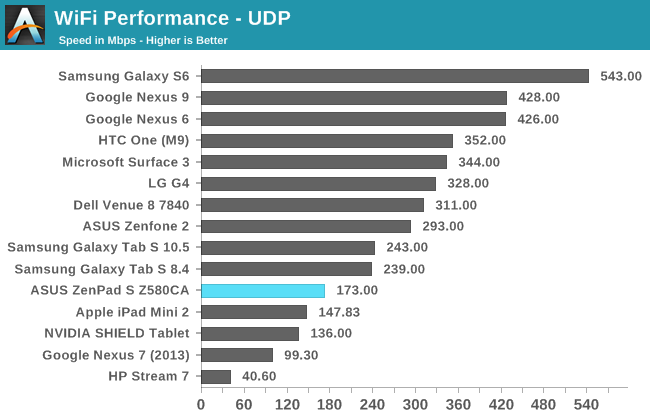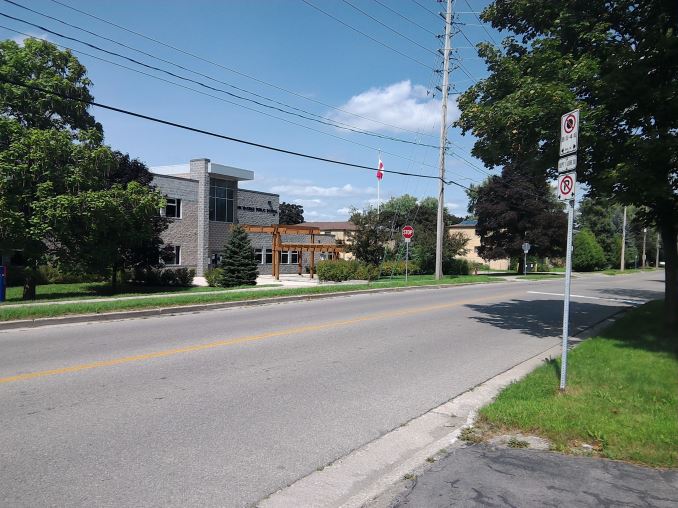The ASUS ZenPad S (Z580CA) Review
by Brandon Chester on August 31, 2015 8:00 AM ESTCamera
While most people will use either their smartphone or a dedicated camera for taking photos, a tablet can be used in a pinch. Some people even make their tablet their primary camera, whether it be because it's their only device, or because they prefer the larger viewfinder that a tablet offers. While many may still find the idea of taking photos with a tablet to be absurd, one need only look at the people around them to see that for one reason or another tablet photography has become a way that some users choose take photos.
The ZenPad S Z580C sports a 5MP rear-facing camera, and the Z580CA bumps that to an 8MP sensor. Since resolution is only one of many aspects of a device's camera system, I've included some more information about the ZenPad S Z580CA's cameras in the chart below
| ZenPad S (Z580CA) Camera Specifications | |
| Front Camera | 5MP (2592x1944) |
| Front Camera - Sensor | Omnivision OV5670 (1.12 µm, 1/5") |
| Front Camera - Max Aperture | F/2.4 |
| Rear Camera | 8MP (3280x2464) |
| Rear Camera - Sensor | Toshiba T4K35 (1.12 µm, 1/4") |
| Rear Camera - Focal Length | 3.0mm (28mm eff) |
| Rear Camera - Max Aperture | F/2.0 |
The ZenPad has a similar camera stack to the ZenFone 2. Toshiba's T4K35 sensor has a resolution of 8MP with 1.12 micron pixels, while the ZenFone 2 used T4K37 which had the same pixel size but a higher 13MP resolution. Lens aperture and focal length end up being the same as the ZenFone 2 as well.
To evaluate the still image quality of the ZenPad S I've taken photos of my standard photo scene during the day and at night, and compared the results to the other tablets that I have available for testing which includes the Nexus 9, the iPad Air 2, and the Dell Venue 10 7040.
It's clear that the ZenPad S suffers from the exact same processing issues as the ZenFone 2. There's far too much sharpening of the image as well aggressive noise reduction. This can be easily seen in any of the foliage in the frame, and in the lines separating the bricks of the school walls. There's also noise across the entire sky, despite this photo being taken with enough light for the camera to shoot at the base ISO of 50. The still image section of my ZenFone 2 review goes into more detail on these issues, and it's disappointing to see that none of them have been resolved. Relative to the other tablets in my comparison, I would have to say that the ZenPad S takes the lowest quality photos. The exposure and color accuracy is much higher than the Dell Venue 10, but the extreme oversharpening and heavy noise reduction makes the image look more like a painting than a photo.
In low light the ZenPad S continues to perform poorly. Low light scenes really make it clear how much of a photo's quality has to do with the quality of the image processing performed. Both the Nexus 9 and iPad Air 2 share a sensor size and resolution with the ZenPad S, and both actually have smaller apertures. Despite this, they both have a better exposure and a much greater level of detail than the ZenPad S. Unlike the day photo test, I would say that the ZenPad S did take a better photo than the Dell Venue 10, but only because I can't even begin to describe the problems with the Venue 10's photo.
Ultimately, the ZenPad S suffers from the exact same issue as the ZenFone 2, which is poor image processing. The color rendition and exposure of images taken during the day makes it clear that the camera has potential, but the numerous issues with the processing produces poor quality images.
WiFi Performance
Like the ZenFone 2, the ZenPad S Z580CA uses Broadcom's BCM4339 WiFi + Bluetooth solution for wireless connectivity. The implementation in the ZenPad S supports two spatial streams on 802.11ac, which allows for a peak theoretical link speed of 867Mbps. However, the ZenPad S has a software problem that makes real world speeds significantly lower than that.

You may be wondering why the ZenPad S can only get a maximum speed of 173Mbps over UDP when the ZenFone 2 with its 1x1 802.11ac goes as fast as 293Mbps. You may have also noticed that a speed around 150Mbps is very similar to devices with 2x2 802.11n WiFi, and that's exactly the problem. The ZenPad S only works in 802.11n mode, a software problem that should have been found in testing long before the tablet actually shipped. I have tested the ZenPad S with an Apple Airport Extreme 6th gen and a TP-Link Archer C7, and the max link speed remains at 200Mbps in both cases. ASUS has confirmed the issue on their end and is aware of it, and so a software fix should arrive for it at some point. Users are, at the moment, just going to have to live with WiFi that isn't even half as fast as it would be if it was working properly.






















114 Comments
View All Comments
uhuznaa - Monday, August 31, 2015 - link
Things are strange right now: You can get an 8" (retina) iPad Mini 2 for $299 and at the same time Android tablets are either a little bit cheaper and really crappy or more expensive and not really much better.If even Apple is struggling now to sell iPads I somewhat doubt that such Android tablets are selling great now...
retrospooty - Monday, August 31, 2015 - link
I dont know about that. I got the $199 Asus Zenpad S 8 a month ago and am loving it. Like all Androids from OEM's, you really need to spend a bit of time to root it and debloat it to make it shine. Debloated this thing flies. For $199 you get an 8 inch 2048x1536 screen, 32gb storage + SD, great build quality, thin, light, great battery life, fingerprint resistant on all surfaces and the CPU is great as well. I was worried about using an Atom chip, but in actual use, it runs perfectly smooth and cool as well. In fact cooler than any Snapdragon device I have ever used. It doesnt get hot at all, ever and I live in Arizona and it's summer. EASILY the best "bang for your buck" available in a tablet right now from any vendor.MrSavage - Monday, August 31, 2015 - link
@retrospooty, I agree with you. People who review a product at a certain price point who want to compare that to products that are about 1/3 more expensive? Or they simply omit the good features like the 64GB onboard storage in this situation, or the front facing speakers, the stylus support or the microSD slot? As if the $299, 2-year old iPad mini 2 with 16GB storage is a wiser choice. If the reviewer wants big battery life, best this, and best that? Then add another $100 to the price of the Tab S2 8.0 for all the features it's lacking that the Z580CA has.BurntMyBacon - Wednesday, September 2, 2015 - link
I agree and disagree. You are welcome to compare it to a product that is 1/3 more expensive, so long as you make it known that that product is 1/3 more expensive. If you stress the comparison against a disparate competitor, then you need to stress the price differential as well. I agree it is disingenuous to point out things that may bring value on one side (display quality, build, aspect ratio, etc.) while ignoring the value adds on the other (SD slot, Storage, Stylus, etc,).Note: My comparison is between two imaginary products and has no bearing on products explicitly or implicitly called out in this article or thread. Comparison was made only to illustrate the point that talking about value distinctions without all of the data is impossible. You may not value the items you left out, but the party you are talking to might.
BurntMyBacon - Wednesday, September 2, 2015 - link
@retrospooty: Given what I've read about the new Atoms, I would probably consider it a boon to a tablet rather than a point of worry. A lot of people seem to be on an ARM or nothing kick. While I was pretty enthusiastic about ARM processors (still am) and I love the competition and what it has done for Intel's low end, I now find there is a lot to like about the Atoms in this form factor as well. Atom got a bad name from its netbook days when it was, frankly atrocious for the application. Now it has matured significantly from a performance / watt standpoint and is running an OS that doesn't run like dirt on low end processors. Of course another nicety of the Atom is its ability to support alternate x86 operating systems if you really want to, but then you have to question whether it is capable of giving you the experience you want. ARM will probably move ahead with its A72 in the near future, but that's a good thing. A little back and forth is good for keeping things moving.BugblatterIII - Monday, August 31, 2015 - link
Do not trust Asus to fix issues!I had (and still have) a Transformer Prime. They never managed to get that working acceptably.
Base your buying decision on how it is at launch, and if they do manage to fix the issues then count that as a bonus.
MrSavage - Monday, August 31, 2015 - link
Did you not get the dongle they created? The Prime was a design flaw. They couldn't software fix their way out of it. If you didn't or don't have the dongle, then I suppose blame yourself.invinciblegod - Monday, August 31, 2015 - link
oh REALLY, an external GPS dongle to do what it should have done in the first place? No, no one should blame themselves, they should blame asus for making a bad product.MrSavage - Monday, August 31, 2015 - link
A design flaw is a design flaw. You can hold onto that issue for the rest of your life if you so choose. You want to miss out of price friendly Asus products because of a design flaw on a second even generation, ground breaking device, then be my guest. I bet you didn't even know about the dongle. The fact is the issue was resolved, albeit a lousy solution. Again, you hold that against them for the rest of your life. That's your odd choice, and if you're okay with it, then so am I.3DoubleD - Monday, August 31, 2015 - link
The dongle fiasco was far from the worst of it though - missing GPS on a 10" tablet was really not a big deal. The Transformer Prime was a complete failure in the end due to the TERRIBLE eMMC that was used. Storage performance just plummeted after a time and while the occasional TRIM helped a bit, it was (and still is) painful to use. Once you are in an app... not so bad. Navigating Android was like watching grass grow... very choppy, laggy grass.It was very sad what happened to the Prime... I remember when I first got it, it blew away any Android device I'd ever used. It is one of two electronic device or computer component purchases I've completely regretted buying. (The other was an AGP Radeon x850XT... that was just outright stupidity on my part)
So that experience colors my view of all ASUS products now. They make some nice looking devices that sometimes have great value... but I just can't help think that they are not fully tested. (As for their PC components, I've had nothing but good experiences)